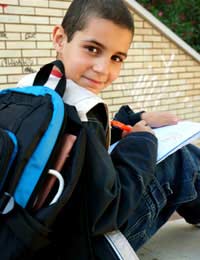Know Your Child's Learning Style

Learning styles vary from person to person. People respond to what they see hear, or feel in different ways and this can greatly affect how they learn and memorise things. There is no right or wrong style but most children will exhibit a preference for one of the basic learning styles. Parents can support their children’s learning by getting to know their learning style and providing the appropriate educational activities.
Types of Learning Style
- Visual - This is the most studied of memorisation learning styles today. The reason for this is that more than half of the human population are visual learners. Children in this category understand and remember concepts better if their educational materials come with a graph, pictures, or allow them to associate concepts with a visual scenario. The use of computers and drawing can help to promote learning for a visual learner.
- Auditory - Children in this category prefer to listen to lessons rather than reading or writing them. Their brain can retain information well if they hear it or if the information is in the form of a rhyme or made into a song. If a visual learner can understand and memorise concepts through picture books, an auditory learner can do the same by putting a tune into the concept. As children, we memorised the alphabet this way.
An auditory learner usually learns to read very quickly and can be musically very talented. Older children who are auditory learners can benefit by recording their lessons or study materials and listening to them on CD or MP3 player. In secondary school 80% of instruction is delivered auditory but generally only 10% of students learn best in this way.
- Tactile or kinaesthetic - Learners in this category understand and remember information better if they talk about it to other people. They often need to make physical contact with things they are learning. Most children up to the age of about eight are kinaesthetic learners. A child who is a kinaesthetic learner will usually find it difficult to sit for long periods of time and prefers to constantly be on the move. Hands on activities and experiments can be very beneficial to the kinaesthetic learner e.g. acting out stories, art projects, nature walks and science experiments.
Understanding both your own and your child’s learning style is important in understanding your child better and will assist you in reinforcing the skills that he/she needs to succeed in school. Once you have recognised how your child learns, you will be able to adapt the learning activities that you do with them to accommodate their individual style. This may also prevent your child from feeling the frustration of not performing at their best academically and can improve your child’s accomplishments and sense of achievement.
- Homework Rewards: Are They a Good Idea?
- Useful Homework Materials
- Should We Employ a Homework Tutor?
- The Internet and Homework: Pros and Cons
- Keeping a Homework Diary
- Starting a Homework Club
- Introducing Your Child to Their Local Library
- How Much Homework Should Your Child Be Getting?
- About Home Schooling
- Preparation & Planning Your Homework
- Improve Your Eating Habits
- How Much Should You Help With Homework?
- Importance Of A Good Study Area
- Reward And Praise
- Homework Routine for Your Children
- Improving Your Child's Memory
- Procrastinating Over Homework
- Get The Sleep You Need
- Keep a Posistive Attitude


Re: English Literature: How to Write a Poetry Essay
New Member Introduction – Happy to Join the Community
Re: Speaking and Listening: Storytelling
nice
Re: Starting a Homework Club
Hi I resently start with a homework club do I need to be rgister at socail workers and go to all that proces please need some at advice
Re: Starting a Homework Club
I'm trying to start a homework club business in my community. I wish I could get a mentor who would assist me step by step to achieve…
Re: Starting a Homework Club
Hello, I’ve recently opened my own private after school homework club but I could do with a lot of guidance (Perhaps a mentor) to help…
Re: Starting a Homework Club
Thank you for your info I set up one in my church as I see many struggling maths and science students From just a few we have grown…
Re: How Much Homework Should Your Child Be Getting?
My daughter has just started year 7. She can get 2-4 pieces of home work per day each from 30-45 mins…
Re: How Much Homework Should Your Child Be Getting?
My 8 year old (year 3) daughter gets almost no homework. We are ,and always have, pushed her to succeed,…
Re: How Much Homework Should Your Child Be Getting?
My daughter moved to secondary school in Wales in January 2019. Since then she has had one or two pieces…
Re: Keeping a Homework Diary
I love school I have been told I could go on this app to do homework ??!!